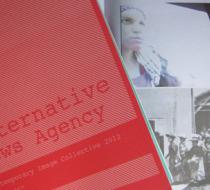Alternative News Agency: revolution's visual narratives revisited 1 Favorite
from ahramonline
by Sara Elkamel
An indelible link has materialised between artistic expression and
revolution. Maybe it is the features they share: freedom, deviance and
fluidity, which bring them so close together.
In any case, Egypt’s January 25 Revolution undeniably led to a
surge of creativity across the country; a rebel’s passion merges with an
artist’s desire to express. Truly remarkable artwork has emerged
throughout the tremendous change and unfolding events.
At the Contemporary Image Collective (CIC) venue in downtown Cairo
on Sunday a diverse group of artists, videographers, photojournalists
presented the Alternative News Agency. It is a publication that emerged
out of a 2-month series of workshops that revolved around questions of
alternative practices in visual media.
Funded by the Dutch Embassy, the Alternative News Agency is the
sequel project to a 2010 pilot working with 12 artists, photojournalists
and bloggers. It aims to place the image-making practitioners in a
critical setting, allowing them to produce individual visual projects
against a collaborative backdrop that provide a more creative narrative
than mainstream media’s often pragmatic rhetoric.
The body of work produced tackles the interplay between mainstream
journalism and artistic expression, placing current events in artistic
context, and in turn, art in a political context.
In weekly self-educational and group-learning sessions, during the
turbulent months of December 2011 to February 2012, the 12 participants
developed ideas of image production and circulation in chaotic
environments.
The sessions were infused with a dual force, a revolutionary one
and an artistic one, which is reflected in the resulting publication.
It also enjoys a lack of unity: each of the participants, who have
emerged from different backgrounds and artistic disciplines, chose a
contrasting angle through which to create a narrative.
Lengthy discussions and dynamic reflections, consequently, underlie the Alternative News Agency.
"Are you joining us in the sauna?" a member of the audience shouted
out to latecomers at the launch event on the warm Sunday evening.
The CIC in Cairo, a photography school located in the heart of
downtown Cairo was packed with an eclectic audience, eager to learn
about the workings behind the collarborative project.
Slowly, the fans stirred a light breeze into the room and the speakers began to explain the idea behind the project.
"This is a different approach to visual media,” said Silvia
Mollicchi, who directed the workshop. "In light of a politically charged
atmosphere, 12 participants produced completely different projects."
The nature of the project was extremely collaborative, says Mollicchi.
The workshop featured guest speakers from diverse fields, including
Egypt Independent editor and journalist Lina Attalah, photographer
Thomas Hartwell, artist Rana El-Nemr and web-developer Tayssir Hawari.
Sessions led by professionals enriched the experience, and harnessed a sense of knowledge sharing.
Jasmina Metwaly, an artist who has been deeply engaged with the
revolution, presents "left-over" images from her activism videos.
Since the revolution, Metwaly has become a sort of “artivist”, combining art and expression with revolution and change.
Metwaly slowly detached from her role as solely a filmmaker and responded to unfolding events through art.
Through collective initiatives such as citizen journalism media
collective Mosireen and Cinema Tahrir, which organises Tahrir-based
screenings of footage from protests and clashes, she helped documented
the revolution.
Metwaly started teaching people to use their phones to capture the unfolding events that were changing their lives.
"As an artist in Egypt, like many others, I started using art for
expression. We have to talk about reality, and learn how to express it,"
Metwaly discusses the importance, under such intense circumstances, of
realising the intermingled realities of revolution and art.
Art loses its abstract qualities in times of resistance and
struggle, Metwaly suggests, and becomes a reality through which artists
can realise socio-political realities.
"There was an urgency to respond to realities, some did it through
Molotov cocktails, others through pictures," says Metwaly with a smile.
"We fight the way we can, with the tools that are available."
In her project, Nadine Marroushi challenges the narratives created
by images through re-imaging scarred spaces in downtown Cairo. The
artist is fascinated with the changing landscape, and examines the
importance of "continuously photographing, constantly shifting to
capture images and preserve history."
Also examining the relationship between the city’s changing
architectural structure and society is Rowan El-Shimi’s photo essay
entitledBreaking Barriers: Walls as a Product of our Society. The artist
was drawn to photography as a means through which to convey truth.
"Words can be misleading, but through photos you can learn truths or
refute lies."
El-Shimi immensely enjoyed the workshop, and firmly believes in the
power of learning simply through conversing with different individuals.
Metwaly shares her sentiments, and describes how the revolution has
created a necessity and longing for artists to work collectively.
"Although we (the participants) come from different backgrounds, being
with the revolution brought us together."
Photographing the Mohamed Mahmoud wall, which was erected after a
five-day long continuous battle between protesters and the police on the
surrounding streets, which was later taken apart by residents and
passersby, El Shimi captured the socio-political contexts in which urban
landscape exists.
The Alternative News Agency is another project that reflects the
unavoidable link between art and revolution. Artists living in Cairo are
surrounded with a barrage of political happenings and the line is often
blurred between artwork and journalistic content.
Yet the publication produced throughout this workshop displays the
raw and free nature of art, and its unique ability to give alternative
narrative to current socio-political events.
Alongside the launch of the Alternative News Agency, the CIC is
hosting a series of talks under the title, Parallel Narratives. A talk
and debate about contrasting visual narratives with Laura Cugusi will
take place on Monday 14 May 14at 7pm, and The Contemporary Photograph as
a Discursive Document, a talk and debate with photographer and
filmmaker Ronnie Close will be held on Tuesday 15 May at 7 pm.







